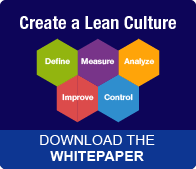One of the most significant stumbling blocks that business process re-engineering initiatives encounter is in the deployment phase of the process improvement process. There is logic and data to suggest that although statistical analyses can improve organizational effectiveness, reduce unnecessary activities, increase productivity, and reduce costs, no process improvement or culture change will occur unless solutions can be implemented through to utilization and Return on Investment. 
What’s Missing is a Standard Deployment Approach
Lean/Six Sigma and other continuous improvement efforts have proven themselves time and time again to be invaluable methodologies for solving problems. But once the problems are solved, the solutions, which inherently involve a behavioral change, need to be implemented. The missing piece is a standard deployment approach that addresses the critical “human side” of solution implementations.
The fact is... there is no improvement unless people change their behavior and use the new process, as intended, on a sustained basis!
One major reason for sub-optimized results is that the quality of the implementation doesn’t match the quality of the solutions that are derived from using the approach. The newly designed processes aren’t purposefully integrated with the people who are actually using the process. Solutions are rigorously designed, but less rigorously implemented. As one Master Black Belt suggested, “Implementation is the missing additional “I” in DMAIC.”
The Right Step
Business process re-engineering will only be successful if the improvements are fully implemented and achieve long-term adoption {Tweet This}. The success metrics for “fully implemented” means solutions are delivered on time, on budget, all business, technical and human objectives met. To achieve these metrics, deployment requires:
- Selection of the right people for implementation (Agents)
- Active, visible leadership (Sponsors)
- Targeted personal rewards and negative consequences, along with environmental supports (Reinforcement)
- Methods for identifying and managing resistance, and strategies for creating Change Readiness
The application of a structured change management process such as the Accelerating Implementation Methodology (AIM) dramatically improves the likelihood of success for operational excellence initiatives. AIM offers a robust set of tools and measurement diagnostics, along with a structured framework for managing the human elements of continuous improvement efforts. This is supplemented by organizational learning to provide practical tactics and strategies that will increase internal capacity to implement more quickly.
AIM’s structured approach and tools can be overlaid on top of Lean/Six Sigma to increase the likelihood of successful deployment. In adopting both Lean Six/Sigma and AIM, organizations benefit from the application of not one, but two proven approaches to improve process performance. The first is working to identify problem areas, the second to ensure a successful implementation.
5 Actions to Increase the Effectiveness of Your Continuous Improvement Projects
To improve your own organization’s Lean/Six Sigma results, we recommend the following specific actions become part of your business process re-engineering protocols:
-
Apply the same data-based approach to the human elements through use of diagnostics such as the Implementation History Assessment, Implementation Risk Forecast, Sponsor Assessment, and Change Agent Assessment that identify implementation barriers.
-
Define the desired behaviors (who will need to do what differently, and how well will they need to do it) up-front so that they can be measured and reinforced on the back-end. These are the human objectives for the change.
-
Develop implementation plans that blend technology and business process improvements with structured, hard deliverables for the human elements, including key role maps, impact mapping, a Sponsorship Strategy and a Reinforcement Strategy that can be seamlessly managed as part of the technical project plan.
-
Re-define the role of the Sponsor from providing high-level “support” based on organizational position to providing three specific behavioral actions: Expressing, Modeling, and Reinforcing the desired behaviors for those impacted by the change.
-
Develop a Readiness Strategy that specifically includes actions for sourcing and managing Resistance to changes resulting from Lean/Six Sigma solutions.
These five actions will significantly increase the effectiveness of your continuous improvement initiatives. And as we all know, these efforts are more important than ever to organizational effectiveness and perhaps, even organizational survival.


